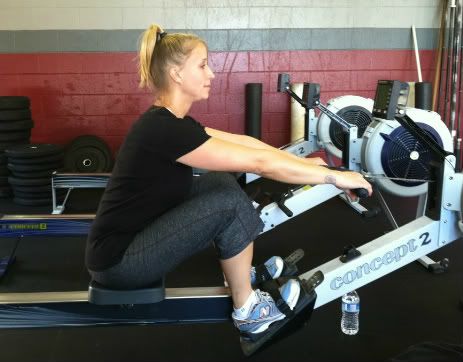What's the Catch?
/ The main faults we see with rowing technique are noticed in the start position, also known as the “catch”. Two errors in the catch commonly seen are rounded backs and extreme shoulder blade protraction. In order to transfer force through your body as effectively as possible, in turn generating the most power (the assumed goal), you cannot be broken like this. What that means is that if your shoulder blades are protracted off your back or if your back is rounded, then the force you want to transfer through your body and to the rower will be hindered by those disconnected areas. You can simply fix these two faults by positioning yourself similarly to how you would in a clean, with a set back. Gia shows a great catch position in the picture above.
Not only is it more effective for generating power to be in this set up, it also puts us in a healthier position. We get away with rounded back rowing like this because there is not a huge load being moved. But even if it's equal to only a pound, it all adds up over time, putting us in a more likely to get injured spot we do not want to be in. Good thing this is completely avoidable with current common knowledge. We wouldn't consider it o.k. to let someone pull a heavy clean off the ground with an intense shoulder blade protraction and a completely rounded back. The same importance should be placed on the catch position in rowing.
Another important piece that Gia shows here, which is also not commonly seen, is her hip flexion in the catch. By flexing the hip, the powerful muscles of the posterior chain are loaded with the potential to create force. It is the same reason we "prep" the olympic hang movements by flexing the hip. In order to generate power there first has to be the potential to create it.
The main faults we see with rowing technique are noticed in the start position, also known as the “catch”. Two errors in the catch commonly seen are rounded backs and extreme shoulder blade protraction. In order to transfer force through your body as effectively as possible, in turn generating the most power (the assumed goal), you cannot be broken like this. What that means is that if your shoulder blades are protracted off your back or if your back is rounded, then the force you want to transfer through your body and to the rower will be hindered by those disconnected areas. You can simply fix these two faults by positioning yourself similarly to how you would in a clean, with a set back. Gia shows a great catch position in the picture above.
Not only is it more effective for generating power to be in this set up, it also puts us in a healthier position. We get away with rounded back rowing like this because there is not a huge load being moved. But even if it's equal to only a pound, it all adds up over time, putting us in a more likely to get injured spot we do not want to be in. Good thing this is completely avoidable with current common knowledge. We wouldn't consider it o.k. to let someone pull a heavy clean off the ground with an intense shoulder blade protraction and a completely rounded back. The same importance should be placed on the catch position in rowing.
Another important piece that Gia shows here, which is also not commonly seen, is her hip flexion in the catch. By flexing the hip, the powerful muscles of the posterior chain are loaded with the potential to create force. It is the same reason we "prep" the olympic hang movements by flexing the hip. In order to generate power there first has to be the potential to create it.
Workout:
5 Rounds:
1 minute Rowing (cal)
1 minute of rest
then,
2 rounds:
1 minute partner med ball sit up
1 minute partner burpees (1 person working at a time)
1 minute rest
Programming: Gary


